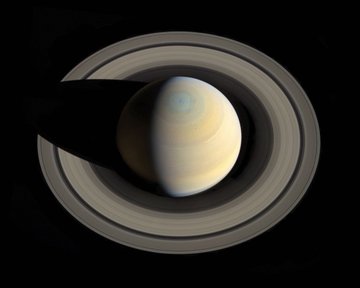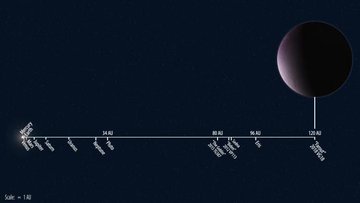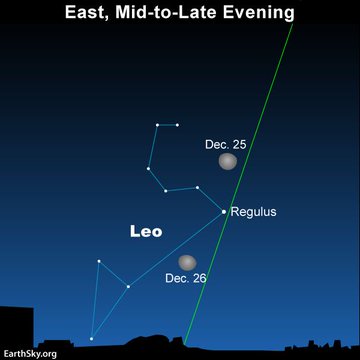-
A fast-moving comet is headed toward an encounter with the sun and Earth. It might soon be within reach of binoculars and small telescopes.

 More info: http://bit.ly/2ERVGzE
More info: http://bit.ly/2ERVGzE  Comet C/2018 Y1 (Iwamoto) is seen at the bottom of this beautiful image by Rolando Ligustri.
Comet C/2018 Y1 (Iwamoto) is seen at the bottom of this beautiful image by Rolando Ligustri. -
See brightest star Sirius at midnight on New Year’s Eve


 http://bit.ly/2BGvaFy Dog Star Sirius reaches its highest point in the sky around midnight every New Year. For this reason, it might also be called the New Year's star.
http://bit.ly/2BGvaFy Dog Star Sirius reaches its highest point in the sky around midnight every New Year. For this reason, it might also be called the New Year's star.  via Project Nightflight
via Project Nightflight -
Beautiful lunar corona caught last night at moonrise over Vancouver Island by James Younger. "Happy New Year from Vancouver Island tonight," he wrote.
Read about what makes these: http://bit.ly/2CyUNcU -
False-color image of Ceres-largest body in the asteroid belt-from the Dawn spacecraft
 . The image shows Ceres' famous bright spots, and the false color highlights differences in surface materials.
. The image shows Ceres' famous bright spots, and the false color highlights differences in surface materials.  via NASA PhotoJournal.
via NASA PhotoJournal.
What does Ceres’ carbon mean? http://bit.ly/2VdKhPK -
Yuri Beletsky Nightscapes captured this lenticular cloud on a mid-December night in the Chilean Andes Mountains.

 “It was truly majestic experience standing in the middle of the dry salt lake area peering into the endless sky.” Read more: http://bit.ly/2TbbDnE
“It was truly majestic experience standing in the middle of the dry salt lake area peering into the endless sky.” Read more: http://bit.ly/2TbbDnE 
-
Why do stars look brighter at this time of year?
 Looking up on December, January and February evenings, the stars seem brighter. Here’s why: http://bit.ly/2EObxOP
Looking up on December, January and February evenings, the stars seem brighter. Here’s why: http://bit.ly/2EObxOP
Image via via NASA/JPL/Caltech/R.Hurt. -
Image Tonight … Moon and a Royal Star.

 Regulus is considered to be the most important of the 4 Royal Stars of ancient Persia. The other 3 Royal Stars are Antares, Fomalhaut, and Aldebaran. Read more: http://bit.ly/2rTtkg5
Regulus is considered to be the most important of the 4 Royal Stars of ancient Persia. The other 3 Royal Stars are Antares, Fomalhaut, and Aldebaran. Read more: http://bit.ly/2rTtkg5 
-
Eureka! Astronomers find a fossil from the Big Bang.
 Only 2 other fossil clouds are known in our universe, and both were serendipitous discoveries. Astronomers began searching for more, and they found one! Read more: http://bit.ly/2ERQGeH
Only 2 other fossil clouds are known in our universe, and both were serendipitous discoveries. Astronomers began searching for more, and they found one! Read more: http://bit.ly/2ERQGeH 
Image via TNG COLLABORATION. -
Is time travel possible? Sure it is, says this physicist, but only if you have an object with infinite mass. Here’s the story of how to build a time machine, with a design that's deceptively simple.
 Read more: http://bit.ly/2Tb9sjY
Read more: http://bit.ly/2Tb9sjY 
Image via Panzi. -
Scientists have long said that Saturn's glorious rings may be only temporary. New research confirms a "ring rain" onto Saturn that'll leave the planet ringless in 100 to 300 million years.
 Watch a video: http://bit.ly/2CqbXJM
Watch a video: http://bit.ly/2CqbXJM 
Image via NASA/Cassini.
-
Popular at EarthSky ... Parker Solar Probe has now swept within the sun's corona.

 No other spacecraft has ever come this close to the sun's surface! And, it's going to get closer. Read more: http://bit.ly/2CmRLIM
No other spacecraft has ever come this close to the sun's surface! And, it's going to get closer. Read more: http://bit.ly/2CmRLIM 
-
The December solstice kicked off Earth's shortest season
 from the December solstice to the March equinox. The current season is about 89 days. Longest season - June solstice to September equinox - is about 94 days. Read more: http://bit.ly/2EsC8B3
from the December solstice to the March equinox. The current season is about 89 days. Longest season - June solstice to September equinox - is about 94 days. Read more: http://bit.ly/2EsC8B3 
-
Popular at EarthSky ... new solar system object more than 100 times Earth's distance from our sun. It takes 1,000 earthly years to orbit the sun once.
 Astronomers have nicknamed it Farout! Read more: http://bit.ly/2Ci06xt
Astronomers have nicknamed it Farout! Read more: http://bit.ly/2Ci06xt 
-
Last Friday, NASA's Juno spacecraft made its 16th science pass over Jupiter's cloud tops, marking the halfway point in its prime mission.
 Check out this bonanza of amazing images: http://bit.ly/2EqtBi8
Check out this bonanza of amazing images: http://bit.ly/2EqtBi8 
-
This weekend's full moon over the Chinese Lantern Festival in Durham, North Carolina, via our friend Chirag Upreti. Thanks, Chirag!
Read more about the festival here: http://bit.ly/2QQ5Y9O -
50th anniversary of 1st Earthrise photo from moon.
 Tomorrow marks 50 years since Apollo 8 astronauts captured one of the best-known photos of the 20th century – Earthrise from the moon. Watch a video: http://bit.ly/2T9enSL
Tomorrow marks 50 years since Apollo 8 astronauts captured one of the best-known photos of the 20th century – Earthrise from the moon. Watch a video: http://bit.ly/2T9enSL 
Image via NASA.
-
On the nights of December 25 and 26, look for the moon and Regulus, the Royal Star, coming up above your eastern horizon.
 If you miss it, you can get up before daybreak to view the waning gibbous moon and Regulus much higher up in the sky. Read more: http://bit.ly/2rTtkg5
If you miss it, you can get up before daybreak to view the waning gibbous moon and Regulus much higher up in the sky. Read more: http://bit.ly/2rTtkg5 
-
The moon is in front of the constellation Gemini tonight, near its brightest stars Castor and Pollux.
 On December 24, you'll find the moon farther from these stars but still near enough to help you find them. Read more: http://bit.ly/2T4oCaP
On December 24, you'll find the moon farther from these stars but still near enough to help you find them. Read more: http://bit.ly/2T4oCaP 
-
It's the case of the vanishing exoplanet. Astronomers have found an exoplanet - 2nd of its kind now - that's gradually "evaporating."
 It may have lost 35% of its original mass, so far. Read more: http://bit.ly/2rQN6Jd
It may have lost 35% of its original mass, so far. Read more: http://bit.ly/2rQN6Jd 
Image via NASA/ESA/D. Player (STScI).
-
New Horizons is approaching Ultima Thule!
 The spacecraft has been given a "go" to take the optimal path past Ultima Thule, which is a billion miles beyond Pluto. The encounter will be on January 1, 2019. Read more: http://bit.ly/2CvzVn2
The spacecraft has been given a "go" to take the optimal path past Ultima Thule, which is a billion miles beyond Pluto. The encounter will be on January 1, 2019. Read more: http://bit.ly/2CvzVn2 
image via Johns Hopkins.
There are no more Tweets in this timeline.





















